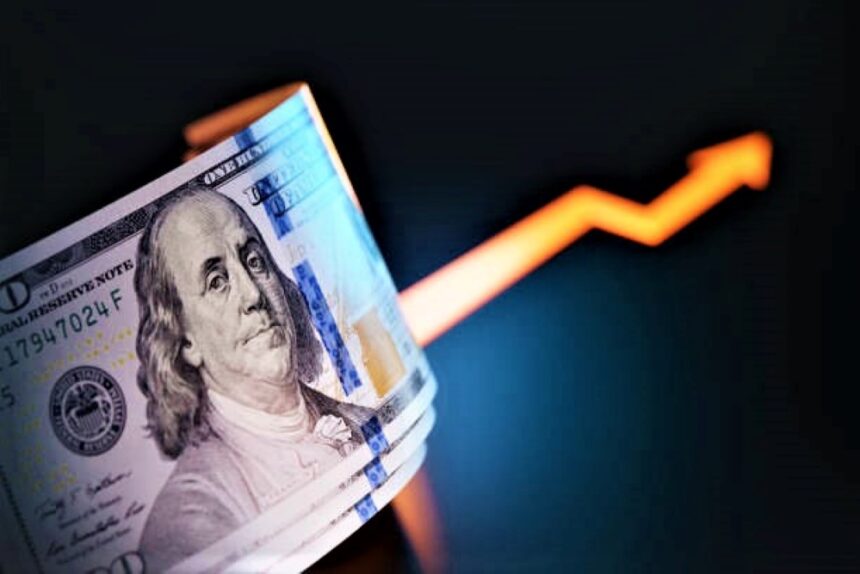Geopolitical Crisis Sparks Dollar Recovery Amid Risk-Off Sentiment
The US Dollar Index (DXY) has recovered sharply above the 98.00 mark on Friday, regaining its footing against a basket of major currencies. This resurgence comes in the wake of intensifying hostilities between Israel and Iran, with markets reacting strongly to news that Israeli forces had launched a series of airstrikes targeting Iranian nuclear facilities.
The flight to safety has given the US Dollar renewed strength as risk appetite wanes. Tensions in the Middle East have historically triggered sharp moves in currency, commodity, and equity markets, and the current geopolitical backdrop is proving no different. Investors are pulling out of riskier assets and reallocating capital into traditional safe havens like the US Dollar and US Treasuries.
Trump’s Rhetoric Heats Up: Global Uncertainty Grows
Adding fuel to the fire, US President Donald Trump delivered forceful remarks on social media Friday, asserting that Iran had repeatedly failed to negotiate a peaceful resolution. “I gave Iran chance after chance to make a deal… just do it,” Trump declared, accusing Tehran of squandering diplomatic opportunities.
This rhetoric has raised serious questions regarding Washington’s potential role in backing or encouraging the Israeli operation. While the US administration has not formally acknowledged direct involvement, Trump’s statement and longstanding alliance with Israel leave room for speculation, prompting renewed concerns about regional and global escalation.
The potential for further escalation involving global powers, particularly if Iran retaliates or if US military assets in the region are targeted, adds significant geopolitical risk premium to financial markets.
Oil Prices Surge: Inflationary Pressures on the Horizon
The energy market has responded swiftly to the developments, with crude oil prices surging in early Friday trading. The threat of oil supply disruptions in a region that produces roughly 30% of the world’s crude has reignited inflation fears that had recently started to subside.
In the past week, US economic data had pointed to easing price pressures, with both the Consumer Price Index (CPI) and Producer Price Index (PPI) undershooting consensus estimates. These softer inflation prints had prompted speculation that the Federal Reserve might shift toward a more accommodative stance later in the year.
However, the sharp jump in oil prices throws that narrative into question. If the energy shock proves persistent, it could rekindle inflation—particularly headline inflation—and complicate the Fed’s policy calculus.
US Dollar’s Safe-Haven Appeal Returns—But for How Long?
Historically, during geopolitical crises, the US Dollar enjoys broad-based strength due to its status as the global reserve currency and a reliable store of value. In this case, the dollar’s rally has been concentrated against G10 currencies, many of which are more sensitive to global growth conditions and commodity prices.
However, the durability of this rally may depend on whether the market sees the conflict as contained or spiraling into a broader regional war. If tensions escalate to the point that US forces become directly involved, the dollar could lose some of its shine as investors turn to other havens like gold, the Swiss franc (CHF), or Japanese yen (JPY).
Upcoming Economic Data: UoM Sentiment and Inflation Expectations in Focus
Aside from geopolitical headlines, investors are also eyeing Friday’s scheduled economic data releases. The University of Michigan’s Consumer Sentiment Index and its one-year and five-year inflation expectations for June could provide insight into how American consumers perceive economic conditions and future price pressures.
Given that consumer sentiment can influence spending behavior, which in turn affects GDP growth, the Fed monitors these metrics closely. Of particular interest will be whether consumers expect energy prices to remain elevated, which could lead to upward revisions in long-term inflation expectations—a key Fed concern.
Global Reaction: Allies Distance Themselves From Israeli Strikes
Israel’s unilateral decision to attack Iran’s nuclear facilities has drawn widespread criticism from both Western and Eastern powers. Notably, Saudi Arabia—an often-aligned regional power—has condemned the action, citing its potential to destabilize the Middle East further.
China has also expressed its disapproval. In a statement, foreign ministry spokesman Lin Jian called on all parties to exercise restraint and offered Beijing’s assistance in defusing tensions. “China urges all relevant parties to do more to promote regional peace and stability and to avoid further escalation,” he said.
The bipartisan backlash against Israel’s actions may put Washington in a diplomatically precarious position. Should the US be perceived as complicit, whether politically or militarily, it risks further straining relationships with key global trading partners such as China and Saudi Arabia—both critical to US economic interests and broader global market stability.
Uas Dollar Outlook: Safe Haven Tailwind vs. Inflation Headwind
The US Dollar Index is currently benefiting from risk aversion, but the sustainability of this rebound will hinge on a delicate balance between rising geopolitical tensions and mounting inflation concerns. If oil prices continue to climb and feed through into consumer prices, the Fed may be forced to delay or even reverse its projected rate-cut timeline.
Such a shift would paradoxically support the dollar via higher yields, but at the cost of slower economic growth—a tradeoff that will likely keep markets on edge.
At the same time, if the situation in the Middle East de-escalates swiftly, the safe-haven bid for the US Dollar could evaporate just as quickly, especially if the Fed proceeds with rate cuts as previously anticipated.
Market Implications: Bonds, Equities, and Commodities
- Treasuries: US Treasury yields initially dipped on Friday as traders sought refuge in sovereign debt. However, should inflation expectations begin to rise due to higher energy prices, yields may resume their upward march—especially on the long end of the curve.
- Equities: Global equity markets have broadly retreated on the news, with tech and growth stocks particularly hard hit amid fears of prolonged instability. Energy and defense sectors, however, are seeing gains.
- Gold: The precious metal has surged past key resistance as investors look beyond the USD and into hard assets with intrinsic value. Gold could continue to rise if inflation ticks up or if the dollar rally stalls.
- Oil: Brent crude and WTI are both up sharply, with Brent crossing above $90 per barrel. If Iran retaliates by closing the Strait of Hormuz—a critical shipping route—the impact on oil markets could be catastrophic, driving prices even higher and intensifying inflationary pressure.
Bottom Line: Crisis-Driven US Dollar Rally Faces Dual Risks
The US Dollar is once again proving its resilience in times of global stress. However, its strength is not without risks. Rising oil prices and the potential for a broader military conflict represent a double-edged sword: while they support near-term dollar demand, they could also undermine US economic stability and monetary policy flexibility over the longer term.
With the Federal Reserve still walking a tightrope between inflation control and supporting growth, and with global tensions at boiling point, the trajectory of the DXY remains highly uncertain. Traders should brace for volatility and remain attuned to both economic data and geopolitical headlines.
[faq-schema id=”39885″]









